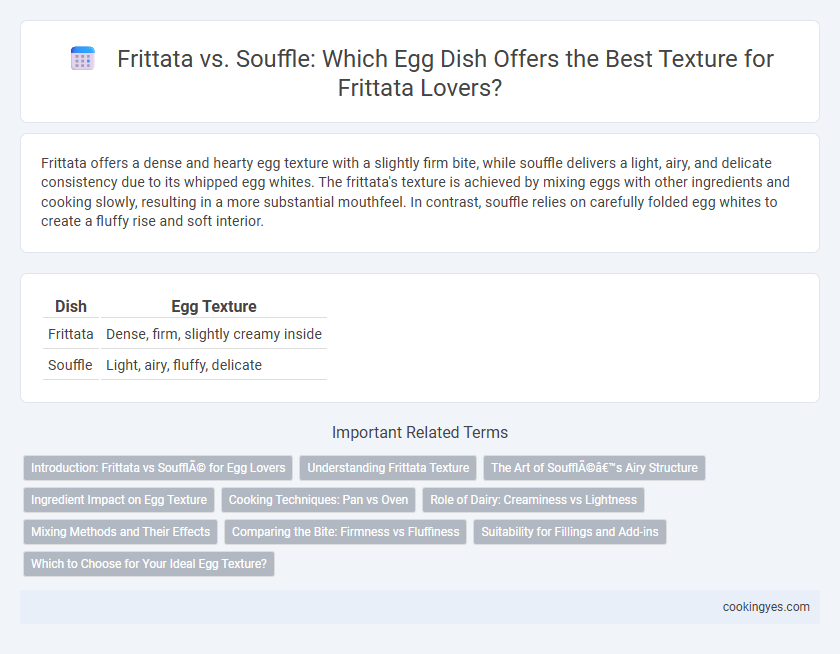Frittata offers a dense and hearty egg texture with a slightly firm bite, while souffle delivers a light, airy, and delicate consistency due to its whipped egg whites. The frittata's texture is achieved by mixing eggs with other ingredients and cooking slowly, resulting in a more substantial mouthfeel. In contrast, souffle relies on carefully folded egg whites to create a fluffy rise and soft interior.
Table of Comparison
| Dish | Egg Texture |
|---|---|
| Frittata | Dense, firm, slightly creamy inside |
| Souffle | Light, airy, fluffy, delicate |
Introduction: Frittata vs Soufflé for Egg Lovers
Frittata delivers a dense, hearty egg texture with a slightly crispy edge, appealing to those who enjoy a substantial, savory bite. Souffle offers a light, airy, and delicate texture, achieved through whipped egg whites that create an elegant, fluffy finish. Egg lovers seeking robust flavor and texture will prefer frittata, while those desiring a refined, cloud-like sensation gravitate toward souffle.
Understanding Frittata Texture
Frittata texture is dense and hearty, achieved by slow cooking eggs mixed with vegetables, cheese, or meats, resulting in a firm yet creamy interior. Unlike the light, airy texture of a souffle created by whipped egg whites, a frittata's eggs are beaten whole, providing a satisfying, custard-like consistency. Mastering low, even heat ensures the frittata is tender without becoming rubbery or dry, emphasizing its rich, substantial mouthfeel.
The Art of Soufflé’s Airy Structure
The art of souffle's airy structure creates a light, delicate texture achieved through carefully whipped egg whites folded into the base mixture. Unlike the dense and hearty frittata, which maintains a firm and custardy consistency, souffle's cloud-like rise relies on the precise incorporation of air to produce its signature fluffiness. This textural contrast highlights the souffle's unique ability to balance tenderness with volume, making it a standout preparation in egg-based dishes.
Ingredient Impact on Egg Texture
Frittata achieves a dense, custard-like egg texture by incorporating whole eggs mixed with various fillings like vegetables, cheese, and meats, which contribute moisture and additional density. Souffle relies heavily on whipped egg whites folded into the base mixture, creating a light, airy, and delicate structure due to the trapped air. The absence of whipped egg whites in a frittata results in a firmer, more cohesive texture, whereas souffle's structure depends on the leavening power of air incorporated during whipping.
Cooking Techniques: Pan vs Oven
Frittatas develop a dense, creamy egg texture through slow cooking on the stovetop using a skillet or nonstick pan, allowing gentle heat to set the eggs without creating air pockets. Souffles rely on carefully folded whipped egg whites and baking in the oven, which traps air and produces a light, airy, and puffed texture. The pan-based cooking of frittatas promotes a custard-like consistency, while oven-baked souffles achieve volume and fluffiness by incorporating steam and heat from all sides.
Role of Dairy: Creaminess vs Lightness
Frittata incorporates dairy such as cheese or milk to create a creamy, dense texture that enhances the rich egg base, while souffle relies on whipped egg whites to achieve a light, airy consistency with minimal dairy influence. The higher fat content from cream or cheese in frittatas results in a moist, tender bite, contrasting with the souffle's delicate, almost fluffy structure. This fundamental difference in dairy use directly impacts the mouthfeel, making frittatas hearty and souffles ethereal.
Mixing Methods and Their Effects
Frittata achieves a dense, hearty egg texture through minimal mixing, which preserves larger curds of egg and creates a more substantial bite. Souffle's texture depends on folding stiffly beaten egg whites into the yolk mixture, producing a light, airy result due to incorporated air pockets. The contrast in mixing methods directly affects moisture retention and fluffiness, with frittatas offering a more custard-like consistency and souffles delivering an elevated, delicate rise.
Comparing the Bite: Firmness vs Fluffiness
Frittatas offer a firm, dense texture with a slightly custardy bite, while souffles present an airy, light, and fluffy consistency due to beaten egg whites. The frittata's structure holds together well, making it suitable for slicing and serving in wedges, whereas souffles provide a delicate, cloud-like mouthfeel that deflates quickly once removed from the oven. The difference in texture is primarily driven by the preparation methods: frittatas incorporate whole beaten eggs, and souffles rely on whipped egg whites for volume and softness.
Suitability for Fillings and Add-ins
Frittatas offer a denser, creamier egg texture that holds up well to a variety of fillings like vegetables, cheeses, and meats, making them ideal for hearty add-ins. Souffles have a light, airy texture created by whipped egg whites, which can be overpowered or deflated by heavy fillings, limiting their suitability. For recipes requiring robust, chunky ingredients mixed into the egg base, frittatas provide superior structural support and flavor integration.
Which to Choose for Your Ideal Egg Texture?
Frittatas offer a dense, creamy texture with a slightly firm edge, making them ideal for those who prefer a hearty, satisfying bite. Souffles deliver a light, airy, and fluffy texture achieved through whipped egg whites, perfect for a delicate, melt-in-your-mouth experience. Choosing between frittata and souffle depends on whether you desire a rich, substantial egg dish or a tender, ethereal texture.
Frittata vs Soufflé for Egg Texture Infographic

 cookingyes.com
cookingyes.com